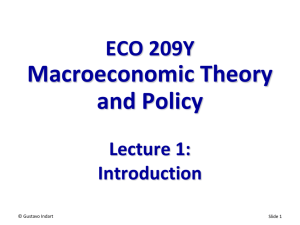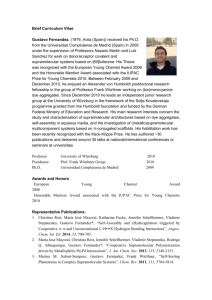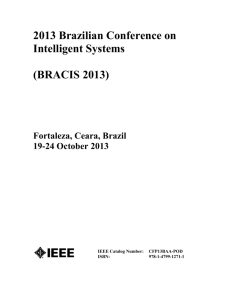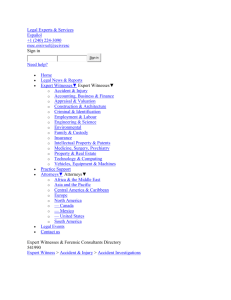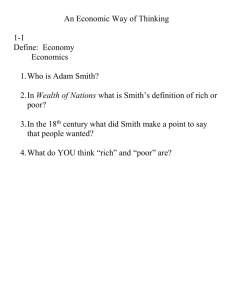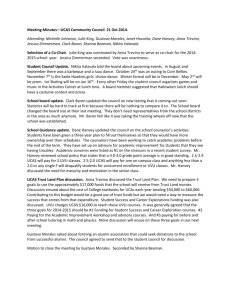Lecture 1
advertisement
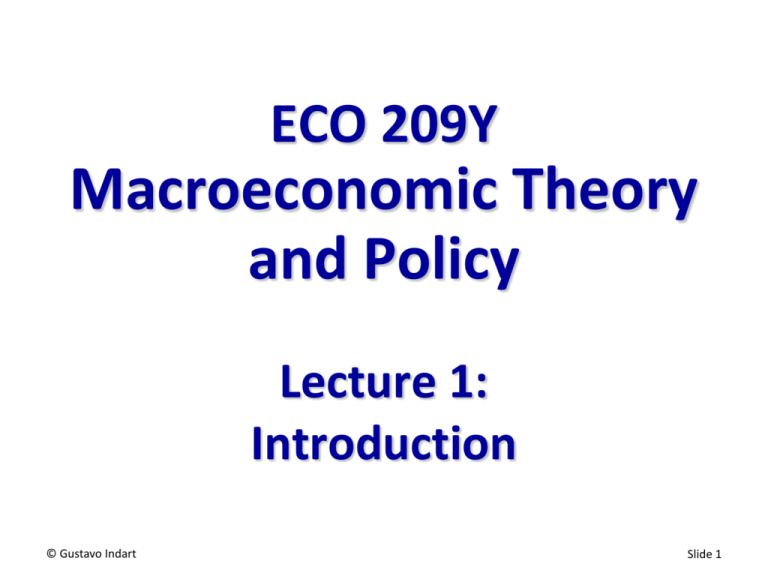
ECO 209Y Macroeconomic Theory and Policy Lecture 1: Introduction © Gustavo Indart Slide 1 Branches of Economics Microeconomics is concerned with the study of the choice problem faced by the economic agents: households and firms e.g., how the equilibrium price for a particular commodity is determined Macroeconomics is concerned with the study of the economy as a whole e.g., how the general level of prices is determined (and not the price of any particular commodity) © Gustavo Indart Slide 2 The Object of Macroeconomics How the general level of prices is determined? What determines the percentage of the labour force that is unemployed? What determines a country’s level of aggregate output or GDP? What determines the level of interest rates? What determines the foreign exchange rate? What determines a country’s balance of payments with the rest of the world? © Gustavo Indart Slide 3 The Rate of Inflation The inflation rate (π) is the percentage increase in the level of prices during a given period: π= P − P-1 P-1 where P is the current price level and P-1 is the price level at the end of the previous period. © Gustavo Indart Slide 4 Canada: Inflation and Deflation Source: P. Krugman, R. Wells and A. Myatt, Macroeconomics. © Gustavo Indart Slide 5 Canada: Annual Change on CPI January 2004 to September 2015 Source: Trading Economics / Statistics Canada. © Gustavo Indart Slide 6 The Rate of Unemployment The unemployment rate is the fraction of the labour force that cannot find jobs: LF − N u= LF where LF is the size of the labour force and N is the number of employed workers © Gustavo Indart Slide 7 Canada: Unemployment Rate Source: P. Krugman, R. Wells and A. Myatt, Macroeconomics. © Gustavo Indart Slide 8 Canada: Unemployment Rate January 2004 to September 2015 Source: Trading Economics / Statistics Canada. © Gustavo Indart Slide 9 Aggregate Output (GDP) Gross Domestic Product (GDP) is the value of all final goods and services produced in the economy during a given period of time Nominal GDP measures the value of output at the prices prevailing in the period the output is produced Real GDP measures the output at the prices of some base year © Gustavo Indart Slide 10 Canada: Growth in Aggregate Output Source: P. Krugman, R. Wells and A. Myatt, Macroeconomics. © Gustavo Indart Slide 11 Canada: Real GDP Growth January 2004 to September 2015 Source: Trading Economics / Statistics Canada. © Gustavo Indart Slide 12 Canada: Growth in Aggregate Output Source: P. Krugman, R. Wells and A. Myatt, Macroeconomics. © Gustavo Indart Slide 13 Canada: Real GDP per Capita Source: P. Krugman, R. Wells and A. Myatt, Macroeconomics. © Gustavo Indart Slide 14 The Rate of Interest The nominal rate of interest (i) is the actual money interest charged on a loan The real rate of interest (r) is the purchasing value of the interest charged on that loan, that is, the real interest rate is the nominal rate (i) minus the rate of inflation (π): r=i−π © Gustavo Indart Slide 15 Canada: Prime Rate of Interest January 1975 to September 2015 Source: Trading Economics / Bank of Canada. © Gustavo Indart Slide 16 Canada: Prime Rate of Interest January 2004 to September 2015 Source: Trading Economics / Bank of Canada. © Gustavo Indart Slide 17 Canada: Real Prime Rate of Interest January 1975 to September 2015 Source: Trading Economics / Bank of Canada. © Gustavo Indart Slide 18 The Exchange Rate The exchange rate is the relative value of the currencies of two countries We will define the exchange rate (e) to be the value of one unit of foreign currency measured in Canadian dollars The exchange rate for US$ is today approximately e = 1.32 This means that the value of the Canadian dollar is today approximately 1/e = 0.76 i.e., Cdn$1 = US$ 0.76 The level of the exchange rate could be set by the Bank of Canada or be determined by market forces Bank of Canada sets the value of e fixed exchange rate system Market forces determine the value of e flexible or floating exchange rate system Bank of Canada intervenes in the market to avoid sudden jumps managed or dirty floating exchange rate system © Gustavo Indart Slide 19 The Exchange Rate between the Canadian Dollar and the U.S. Dollar January 1950 to September 2015 Source: Trading Economics. © Gustavo Indart Slide 20 Ontario: Changes in Employment in the Manufacturing Sector January 2000 to March 2015 Source: Canadian Centre for Policy Alternatives with data from Statistics Canada. © Gustavo Indart Slide 21 The Balance of Payments The balance of payments is the record of all transactions of the economy with the rest of the world The overall balance of payments is the summation of the balance in two accounts: the current account and the capital account The current account records all the imports and exports of goods and services, investment income, and transfer payments The capital account records the capital flows, that is, investment and borrowing/lending © Gustavo Indart Slide 22 Canada’s Balance of Payments, 2010 Receipt Payment Balance 547,141 598,005 -50,864 Goods and services 476,086 507,844 -31,757 Investment income 61,794 78,230 -16,436 9,261 11,932 -2,671 156,883 107,176 49,707 Current account Transfers Capital account Statistical discrepancy © Gustavo Indart 1,157 Slide 23 Canada’s Current Account Balance as Percent of GDP January 1980 to September 2015 Source: Trading Economics / Statistics Canada. © Gustavo Indart Slide 24 Economic Policy Policy makers use mainly two types of policies to affect the economy: fiscal and monetary policies The government (Parliament) controls fiscal policy, while the Bank of Canada controls monetary policy The instruments of fiscal policy are tax rates and government spending The main instruments of monetary policy are changes in either the stock of money or the bank rate © Gustavo Indart Slide 25
